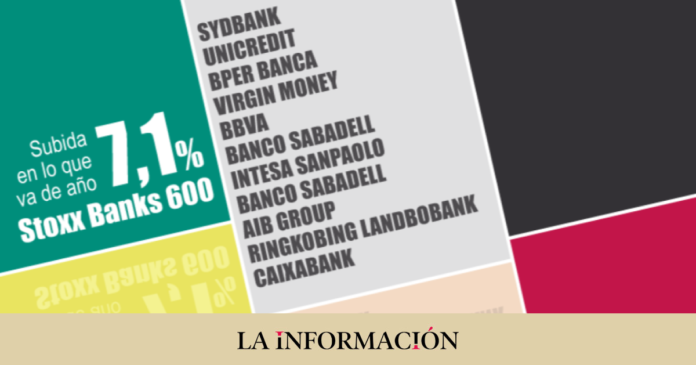European banks are beginning to show signs of slowing down on the stock market. Investors have activated caution during the first months of the year regarding this sector under the premise that 2024 will be a transition. The expectation that interest rates have peaked both in the eurozone and in the European Union as a whole leads the market to be cautious in its commitment to financial securities. So far this year, the Stoxx Banks 600, which includes the 600 largest capitalization entities within the Old Continent, has recorded an increase of 7.1%. The increase is lower than the annual revaluation accumulated just twelve months ago, when the increase was 9.56% in the midst of the financial crisis.
Within this trend, some Italian and Spanish banks stand out, vying for leadership among the ten that rise the most with double-digit rebounds. Specifically, three are of transalpine origin: Unicredit (+31.1%), BPER Banca (+31%) and Intesa Sanpaolo (+19.95%) and three other Spanish: BBVA (+23.88%), Banco Sabadell (+21%) and CaixaBank (+17.7%). In this classification in which the predominance of southern European banks stands out, the Danish Sydbank also appears, which leads the classification with an increase of 32.9%, as well as Ringkjoebing Landbobank (+18.8%), the British Virgin Money (+27.6%), as well as the Irish AIB Group (+18%). The entities of these two southern countries are for now ‘dispelling’ doubts about whether they could maintain last year’s ‘rally’ and once again stand out from the rest of the listed banks of the Old Continent.
Analysts highlight the better position of southern European entities compared to the rest of their counterparts to face the upcoming shift in monetary policy. One of the reasons is that the interest margin of these entities may notice less the effects of an upcoming rate drop due to the low remuneration of liabilities. “The deposit rate continues to be key to the trajectory of net interest income,” they indicate from Bloomberg Intelligence, from which they highlight the “resilience” of Spanish entities when it comes to paying interest on savings. Thus, they point out that combined eurozone deposit rates have increased by almost 80 basis points over the last twelve months, threatening the consensus estimate of 350 billion in interest income.
In Spain, the ‘deposit beta’, as the metric used to analyze the banks’ willingness to pay for your money is known in jargon, is 13%, according to these experts. To put it in context, in Sweden, where interest rates are at 4%, below the 4.5% in the single currency region, the figure reaches 59%, with large differences between corporate clients, who Banks tend to pass on rate increases more quickly than individuals. With data from the Bank of Spain, the weighted average rate of new term deposits formalized last January stood at 2.38%, the lowest since last September, and 200 basis points below the official decreed rates. by BC (4.5%).
Underlying this situation is the fact that the loan to deposit ratio (Loan to Deposit Ratio), that is, the relationship between the volume of credit granted and the total liabilities, is placed in both Spain and Italy slightly below the European average, which at the end of last year stood at over 80% excluding the Nordic countries. Within the perimeter of the eurozone this reaches 94%, one tenth less compared to the third quarter of 2023 in a context of “calm” competition. Registering low levels of LTD avoids the pressure of having to capture new savings, as is now happening in Spain, where entities are betting on strengthening customer loyalty, pushing this rate to 83.4%, according to Álvarez & Mars al.
The latest report on the sector prepared by the consulting firm shows that Spaniards allocated 14,000 million monthly in term deposits last year, with Bankinter and Banco Santander being the ones with the largest share with a volume of almost 30% and 2.5% . respectively. The import is lower than that captured by Treasury Bills, which have become the main rival, with a volume that exceeds 24.4 billion at the end of 2023, 34% of the total. The behavior can also be extrapolated to other surrounding countries such as Italy, where demand for public debt increased by 80% last November, so savings competition goes beyond deposits. Although in this case it is still at low thresholds compared to those registered in 1990, when Italian households owned 80%, compared to 13% at the moment, ‘Bloomberg’ analysts predict that this trend should push firms such as UniCredit or Intesa Sanpaolo to improve their offer to retain retail customers.

